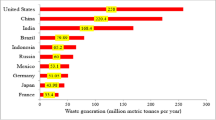Abstract
A flue dust that contains valuable metals is generated during smelting operation for e-waste treatment. However, metal recovery from this flue dust has not been extensively studied. The flue dust can contain valuable metals such as gold, silver, copper, and iron. In this study, the flue dust from e-waste was investigated as the potential metal resource for obtaining valuable metals, including copper and iron, using physical and chemical methods. In the physical processes, size separation was performed, and the mass and composition of each fraction were analyzed. Major valuable elements of the flue dust are copper and iron with small levels of gold and silver in all size fractions. The iron is present mostly as magnetite, as determined by XRD. The magnetite was removed by magnetic separation, and the removal efficiency was about 90%. The chemical processes included leaching in various acid solutions (HNO3, H2SO4, and HCl) for copper recovery. The highest recovery efficiency of over 99% was obtained after 8 h in 1 M nitric acid and was optimized at a pulp density of 20 g/L and a stirring speed of 200 rpm at 20 °C temperature.







Similar content being viewed by others
References
Robinson BH (2009) E-waste: an assessment of global production and environmental impacts. Sci Total Environ 408:183–191. https://doi.org/10.1016/j.scitotenv.2009.09.044
Cui J, Zhang L (2008) Metallurgical recovery of metals from electronic waste: a review. J Hazard Mater 158:228–256. https://doi.org/10.1016/j.jhazmat.2008.02.001
Cui J, Forssberg E (2003) Mechanical recycling of waste electric and electronic equipment: a review. J Hazard Mater B99:243–263. https://doi.org/10.1016/S0304-3894(03)00061-X
Tuncuk A, Stazi V, Akcil A, Yazici EY, Deveci H (2012) Aqueous metal recovery techniques from e-scrap: hydrometallurgy in recycling. Miner Eng 25:28–37. https://doi.org/10.1016/j.mineng.2011.09.019
Veit HM, Juchneski NCDF, Scherer J (2014) Use of gravity separation in metals concentration from printed circuit board scraps. REM R Esc Minas 67:73–79. https://doi.org/10.1590/S0370-44672014000100011
Veit HM, Diehl TR, Salami AP, Rodrigues JDS, Bernardes AM, Tenório JAS (2005) Utilization of magnetic and electrostatic separation in the recycling of printed circuit boards scrap. Waste Manag 25:67–74. https://doi.org/10.1016/j.wasman.2004.09.009
Wu J, Li J, Xu Z (2008) Electrostatic separation for recovering metals and nonmetals from waste printed circuit board: problems and improvements. Environ Sci Technol 42:5272–5276. https://doi.org/10.1021/es800868m
Li J, Jiang Y, Xu Z (2017) Eddy current separation technology for recycling printed circuit boards from crushed cell phones. J Clean Prod 141:1316–1323. https://doi.org/10.1016/j.jclepro.2016.09.144
Khaliq A, Rhamdhani MA, Brooks G, Masood S (2014) Metal extraction processes for electronic waste and existing industrial routes: a review and Australian perspective. Resources 3:152–179. https://doi.org/10.3390/resources3010152
Morales A, Cruells M, Roca A, Bergó R (2010) Treatment of copper flash smelter flue dusts for copper and zinc extraction and arsenic stabilization. Hydrometallurgy 105:148–154. https://doi.org/10.1016/j.hydromet.2010.09.001
Okanigbe DO, Popoola API, Adeleke AA (2017) Characterization of copper smelter dust for copper recovery. Procedia Manuf 7:121–126. https://doi.org/10.1016/j.promfg.2016.12.032
Vítková M, Ettler V, Hyks J, Astrup T, Kříbek B (2011) Leaching of metals from copper smelter flue dust (Mufulira, Zambian Copperbelt). Appl Geochem 26:S263–S266. https://doi.org/10.1016/j.apgeochem.2011.03.120
Kumar M, Lee JC, Kim MS, Jeong J, Yoo K (2014) Leaching of metals from waste printed circuit boards (WPCBs) using sulfuric and nitric acids. Environ Eng Manag J 13:2601–2607
Wasilewski P, Kletetschka G (1999) Lodestone: natures only permanent magnet—what it is and how it gets charged. Geophys Res Lett 26:2275–2278. https://doi.org/10.1029/1999GL900496
Yavuz CT, Mayo JT, William WY, Prakash A, Falkner JC, Yean S, Li Cong, Shipley HJ, Kan A, Tomson M, Natelson D, Colvin VL (2006) Low-field magnetic separation of monodisperse Fe3O4 nanocrystals. Science 314:964–967. https://doi.org/10.1126/science.1131475
Kumari A, Jha MK, Lee JC, Singh RP (2016) Clean process for recovery of metals and recycling of acid from the leach liquor of PCBs. J Clean Prod 112:4826–4834. https://doi.org/10.1016/j.jclepro.2015.08.018
Vračar RŽ, Vučković N, Kamberović Ž (2003) Leaching of copper (I) sulphide by sulphuric acid solution with addition of sodium nitrate. Hydrometallurgy 70:143–151. https://doi.org/10.1016/S0304-386X(03)00075-6
Choubey PK, Panda R, Jha MK, Lee JC, Pathak DD (2015) Recovery of copper and recycling of acid from the leach liquor of discarded printed circuit boards (PCBs). Sep Purif Technol 156:269–275. https://doi.org/10.1016/j.seppur.2015.10.012
Habbache N, Alane N, Djerad S, Tifouti L (2009) Leaching of copper oxide with different acid solutions. Chem Eng J 152:503–508. https://doi.org/10.1016/j.cej.2009.05.020
Acknowledgements
The authors are thankful to the members of the NSF I/UCRC (WPI: 233110) on Resource Recovery and Recycling (CR3) and to the National Science Foundation for their support to this work.
Author information
Authors and Affiliations
Corresponding author
Additional information
The contributing editor for this article was B. Friedrich.
Rights and permissions
About this article
Cite this article
Lee, H., Lee, E., Jung, M. et al. Recovery of Copper from Flue Dust Generated in e-Waste Processing Using Physicochemical Methods. J. Sustain. Metall. 4, 260–264 (2018). https://doi.org/10.1007/s40831-017-0150-4
Published:
Issue Date:
DOI: https://doi.org/10.1007/s40831-017-0150-4




